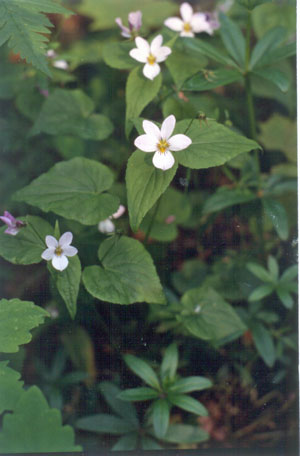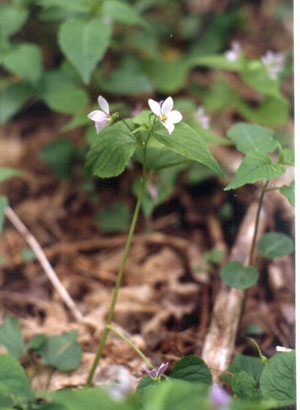DACF Home → Bureaus & Programs → Maine Natural Areas Program → Communities, Plants, and Animals → Rare Plants → Viola canadensis

Viola canadensis L.
Tall White Violet
- State Rank: SH
- Global Rank: G5
- State Status: Potentially Extirpated
Habitat: Rich, mesic, hardwood forests (cove forests). [Hardwood to mixed forest (forest, upland)]
Range: Southwestern Quebec and Northeastern and North Central U.S., south to Pennsylvania and occasionally further south in the mountains. First discovered in Maine in 1993.
Aids to Identification: Plants 20-30 cm tall, with white, five-petalled, and irregular flowers and leaves (at least the lower) heart-shaped. The tall white violet differs from most other violets in bearing leaves on upright stems with the flowers, rather than having the leaves all basal. The petals are sometimes tinged with violet on the backs and often are yellowish at their base. Other white-flowered violets in Maine do not have erect, leafy stems. In fruit, to distinguish from V. pubescens (yellow violet), which also has upright leafy stems and grows in similar habitats, look for capsules 10-12 mm long and seeds 1.5-2 mm long (vs. 5-9 mm capsules and 2-3 mm seeds in V. pubescens), and scarious (dry, translucent) stipules (leafy in V. pubescens).

Ecological characteristics: Also called Canada violet, this is a species of Northern Hardwood Forests (beech-birch-maple or maple-basswood-ash type), usually with sugar maple (Acer saccharum) as a dominant species. It tends to occur in moist soils that are not strongly acid.
Phenology: An herbaceous perennial; emerges in springtime, flowers late May or early June, remains above-ground and may produce cleistogamous flowers (flowers that self-fertilize in the bud and never open) and capsules through the summer.
Family: Violaceae
Synonyms: Maine and New England populations are represented by var. canadensis.
Known Distribution in Maine: This rare plant has been documented from a total of 1 town(s) in the following county: Oxford.
Reason(s) for rarity: Disjunct from main portion of its range, which extends east only to the Vermont/New Hampshire border. Other reasons for rarity are unclear; apparently suitable habitat exists in western and northern Maine.
Conservation considerations: Known populations are small and subject to the vagaries of small populations like random fluctuations or localized disturbance events.